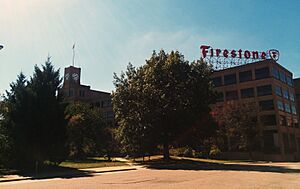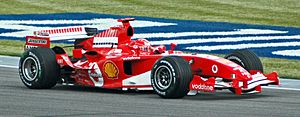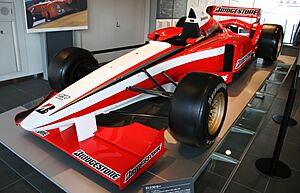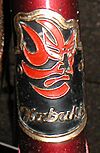Bridgestone facts for kids
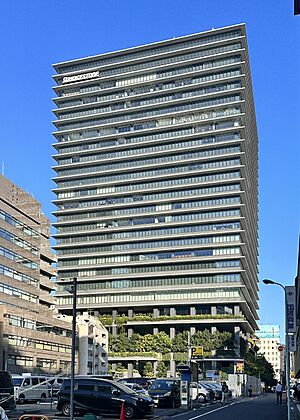
Bridgestone's headquarters in Kyōbashi, Tokyo, Chūō, Tokyo
|
|
|
Native name
|
株式会社ブリヂストン
|
|---|---|
|
Romanized name
|
Kabushiki gaisha Burijisuton |
|
Formerly
|
|
| Public | |
| Traded as |
|
| Industry | Manufacturing |
| Founded | 1 March 1931 Kurume, Fukuoka, Japan |
| Founder | Shojiro Ishibashi |
| Headquarters |
Kyōbashi, Tokyo
,
Japan
|
|
Area served
|
Worldwide |
|
Key people
|
Shuichi Ishibashi (Global CEO) |
| Products | Tires, golf equipment |
| Revenue | |
|
Operating income
|
|
| Total assets | |
| Total equity | |
| Owner | Ishibashi family (10.2%) |
|
Number of employees
|
|
| Subsidiaries |
|
Bridgestone Corporation (株式会社ブリヂストン, Kabushiki gaisha Burijisuton) is a Japanese company that makes many things, especially tires. It was started in 1931 by Shojiro Ishibashi in Kurume, Japan. The name "Bridgestone" comes from a translation of its founder's last name, which means 'stone bridge' in Japanese.
Bridgestone is the biggest tire maker in the world. They also make other products like golf equipment. As of 2018, the Bridgestone Group has 181 factories in 24 countries around the globe.
Contents
History of Bridgestone
How Bridgestone Started
The company began as Bridgestone Tire Company, Ltd. in 1931. However, the very first Bridgestone tire was made earlier, in April 1930. Shojiro Ishibashi, the founder, wanted to make tires using Japanese technology, not just relying on European or North American ideas.
At first, the company faced many challenges with technology, making products, and selling them. But they kept improving the quality of their tires and how they made them. This helped the business grow quickly both in Japan and in other countries.
Challenges During and After World War II
During World War II, strict rules meant that almost all of Bridgestone's tires were used by the military. The war caused a lot of damage to the company. Their main office in Tokyo was destroyed, and they lost all their businesses outside Japan.
Luckily, their factories in Kurume and Yokohama were not damaged. This meant they could start making tires again right after the war ended in 1945. Even after a long worker strike, the company became stronger.
After the war, Bridgestone also started making bicycles in 1949. They even made some motorcycles for a while, but they decided to focus on making tires for other motorcycle companies like Honda and Suzuki.
In 1952, Shojiro Ishibashi also opened the Bridgestone Museum of Art in Tokyo.
New Technologies and Growth
Bridgestone was the first company in Japan to sell tires made with rayon cord in 1951. They also started a big project to make their factories more modern. By 1953, their sales were huge, making them the top tire company in Japan.
In 1959, they began selling nylon tires. A new factory was built in Tokyo in 1960 to keep up with the growing number of cars.
Radial Tires and Global Expansion
In 1961, Bridgestone shares were sold on the stock market. They also started using a new system to improve quality, which helped them win a special award called the Deming Prize in 1968.
A big step forward was in 1967 when they sold their first ever radial tire, called the RD10. Radial tires are designed differently to last longer and perform better.
Bridgestone also started expanding around the world. Their first factory outside Japan after the war opened in Singapore in 1965. They also started making tires in Thailand in 1969 and set up Bridgestone Americas in the United States in 1967 to sell their products.
Even when Japan's economy slowed down, Bridgestone kept working on its own radial tire technology. They introduced the Super Filler Radial in 1978 and the high-performance POTENZA radial tire in 1979. The word "Potenza" means "power" in Italian.
The company continued to grow globally, opening factories in Indonesia and Iran in 1976. They also bought a tire factory in Australia in 1980. The founder, Shojiro Ishibashi, passed away in 1976.
In 1981, Bridgestone celebrated its 50th anniversary. They aimed to become one of the top three rubber product makers in the world. They opened new factories in many countries, including India, Poland, China, and the United States. In 1984, the company changed its name from Bridgestone Tire Co., Ltd. to Bridgestone Corporation.
Buying Firestone Tire and Rubber Company
In 1988, Bridgestone bought the Firestone Tire and Rubber Company, a big tire company from Ohio, USA. Bridgestone put a lot of effort and money into making Firestone successful again. By 1992, Firestone was making a profit.
The Firestone Tire and Rubber Company and Bridgestone Tire Company Ltd. USA joined together in 1990. Today, the main Bridgestone company in North America is called Bridgestone Americas, Inc.
In 2012, Bridgestone Americas opened a new $100 million technical center in Akron, Ohio. This center helps develop new and advanced tire technologies. In 2022, they opened a new $21 million factory in Akron to make racing tires for the NTT IndyCar Series. This is the first new tire factory in Akron in over 70 years.
Bridgestone's Global Locations
Bridgestone has many large factories all over the world. As of April 2011, Bridgestone had 47 tire factories, 29 tire-related factories, and many other plants globally. They also have technical centers and testing grounds.
Here are some of the countries where Bridgestone has major plants:
| Asia/Oceania | Europe | Americas | Middle East/Africa |
|---|---|---|---|
| Australia | Belgium | Argentina | South Africa |
| China | France | Brazil | Cameroon (from 2020) |
| India | Hungary | Canada | Kenya (from 2023) |
| Indonesia | Italy | Colombia | |
| Japan | Poland | Costa Rica | |
| New Zealand | Portugal | Mexico | |
| Pakistan | Spain | United States | |
| Taiwan | Turkey | Venezuela | |
| Thailand | Estonia (from 2024) | Bolivia (from 2027) | |
| Vietnam | Puerto Rico (from 2025) | ||
| Myanmar (from 2021) | |||
| South Korea (from 2022) | |||
| Philippines |
Bridgestone in Australia
Bridgestone Australia's main office is in Eastwood, a suburb of Adelaide, South Australia. Bridgestone took over Australian factories from another company in 1980. They used to have a big tire factory in Salisbury, Australia, but it closed in 2011.
Bridgestone Australia also bought the BANDAG Retreading plant in 2000. Bandag makes retreaded tires, which are old tires that have new tread put on them. This helps save money and resources.
Bridgestone in Europe
Bridgestone EU has its main office in Brussels, Belgium. It was set up in 1990. They have 7 factories and a large research and development center near Rome, Italy. They sell over 25 million tires each year across Europe.
Bridgestone EU also has a program called Truckpoint. This allows truck fleets to get special tire work done at any Bridgestone-approved garage across Europe.
Bridgestone stopped its business in Russia in December 2023.
Bridgestone in North America
Bridgestone bought a factory in Tennessee, USA, in 1983. This was their first factory in North America, and they started making radial tires for trucks and buses there. They also have a factory in Clarksville, Tennessee, that makes steel cord, which is used in tires.
In 1988, Bridgestone successfully bought Firestone Tire and Rubber Company. This brought many Firestone factories around the world into the Bridgestone family.
Bridgestone Americas, Inc. (BSA) is the American part of Bridgestone. They make and sell Bridgestone, Firestone, and other tire brands for cars, trucks, and farming vehicles. They also make other products like air springs and roofing materials. Bridgestone Americas also runs the world's largest chain of car tire and service centers.
In 2017, Bridgestone Americas moved many of its teams into a single tall building in downtown Nashville, called Bridgestone Tower. Almost 2,000 employees work there.
Sports Sponsorships
Bridgestone is very involved in motorsports and other sports.
Formula Racing
Bridgestone started making race tires in the 1980s for racing series like Formula 2 and Formula 3.
To make the Firestone brand more famous, Bridgestone Firestone NAH Ltd. started supplying tires for CART open-wheel racing in 1995. Their tires were so good that another big tire company, Goodyear, left the series. Since then, Firestone has been the only tire supplier for the IndyCar Series.
Bridgestone has supplied tires for Formula One races since 1997. They had supplied tires for a few Japanese teams in 1976 and 1977.
Bridgestone wanted to become more well-known in Europe, so they decided to join Formula One. They quickly developed their tires and started supplying them in 1997.
In their second year, 1998, a driver using Bridgestone tires, Mika Häkkinen, won the championship. Bridgestone tires helped drivers win 5 world championships and teams win 5 constructors' championships between 1998 and 2004. They worked very well with Scuderia Ferrari and Michael Schumacher.
From 2008 to 2010, Bridgestone was the only tire supplier for the FIA Formula One World Championship. On November 2, 2009, Bridgestone announced they would stop supplying tires to Formula One after 2010. Pirelli took over as the sole supplier in 2011.
| Pos | Tire | Seasons | Starts | Wins | Only supplier |
WC Drivers |
WC Constr. |
|---|---|---|---|---|---|---|---|
| 3 | 1976 – 2010 | 244 | 175 | 116 | 11 | 11 | |
| 6 | 1950–1975 | 121 | 49 | 11 | 3 | 3 |
Sports Car and Touring Car Racing
Bridgestone also provided tires for sports car races like the 24 Hours of Le Mans in the 1980s and 1990s. They still supply tires for the Super GT series in Japan. Since April 2023, Bridgestone has been the main tire supplier for the Super Taikyu Series.
Motorcycling
In 2002, Bridgestone entered Grand Prix motorcycle racing (MotoGP). From 2009 to 2015, they were the only tire supplier for the championship. They achieved 100 MotoGP victories in 2012. Famous rider Valentino Rossi won two MotoGP titles on Bridgestone tires.
Bridgestone announced in May 2014 that they would leave MotoGP at the end of the 2015 season.
Other Sports
Bridgestone is the Official Tire of the Olympic Games. They also have the naming rights to the Bridgestone Arena, where the NHL's Nashville Predators play. They were also a main sponsor for major South American club football competitions like Copa Libertadores.
Other Products Bridgestone Makes
Besides tires, Bridgestone makes many other different products. They started making these other products soon after they began making tires in the 1930s. About a quarter of Bridgestone's total sales come from these other businesses.
Automotive and Industrial Products
Bridgestone makes parts for cars, like special parts that reduce vibration from the engine. They also make air springs for trucks, cars, and train carriages. They sell aluminum wheels and other car accessories.
Bridgestone's industrial products include foam for car seats, beds, and furniture. They also make different kinds of hoses, conveyor belts, and rubber tracks for tractors. They even make retreaded tires for aircraft.
For construction, Bridgestone makes special rubber bearings that protect buildings from earthquakes. They also make materials for waterproofing and roofing.
Products for Electronic Equipment and Sports
Bridgestone makes parts for electronic equipment, like rollers for office machines and special films for solar cells. In sports, they make golf balls and clubs, as well as tennis balls and rackets.
Bridgestone Commercial Services Group (Bandag)
In 2006, Bridgestone Americas bought Bandag, Inc., a company that specializes in re-treading truck tires. Re-treading means putting a new outer layer on an old tire, which saves money and resources. This purchase was worth about $1.05 billion.
Bridgestone's president explained that higher fuel prices made customers want to save money by using retreaded tires. The company was renamed Bridgestone Bandag, LLC, and later Bridgestone Commercial Services Group in 2011.
Bicycles
The Bridgestone Cycle Co Ltd. started in 1949. They sell bicycles under their own name and under the Anchor brand.
Bridgestone used to sell bicycles in the U.S. under the name Kabuki. They were known for making strong and comfortable bicycles. They also helped develop early mountain bikes.
Today, Bridgestone still makes bicycle frames in Japan for keirin track racing. They are also known for making utility bikes, mountain bikes, and road racing bikes (under the Anchor brand) in Japan.
Bridgestone has also worked with Alex Moulton to make the Bridgestone Moulton Bicycle, a special folding bike. They also made their own folding bicycle called the Bridgestone Picnica.
Motorcycles
Bridgestone had a division that made mopeds and motorcycles from 1952 to 1970. Their motorcycles were very advanced for their time. However, they stopped making motorcycles in 1970 to make sure they could keep supplying tires to other motorcycle companies.
Bridgestone Aircraft Tire
Bridgestone Aircraft Tire (USA) makes tires for airplanes and also re-treads them. In 2006, they moved their operations to a new facility in Mayodan, North Carolina. This move helped them prepare for new types of aircraft, like the Boeing 787 Dreamliner and Airbus A380, which use Bridgestone's advanced aircraft tires. Bridgestone has been a major supplier of aircraft tires for over 70 years.
Golf Products
Bridgestone Golf is the part of Bridgestone that makes golf products. Bridgestone has been making golf-related items since 1935. Today, they make golf clubs, balls, and other accessories. Thanks to their tire technology, they also made breakthroughs in golf ball technology, becoming the number one golf ball maker in Japan.
They started designing and making golf clubs in 1972. Bridgestone Golf products are sold worldwide, with major divisions in the USA, Australia, and Korea.
Dolphin Artificial Tail Fin
In 2003, a dolphin named Fuji at the Okinawa Churaumi Aquarium lost most of her tail fin due to illness, making it impossible for her to swim. The aquarium worked with Bridgestone to create the world's first artificial tail fin for a dolphin. It was challenging at first, but they succeeded in making a fin that Fuji could use to swim again.
In 2010, they also made a second artificial tail fin for another dolphin named Lanan at the Notojima Aquarium.
See also
 In Spanish: Bridgestone para niños
In Spanish: Bridgestone para niños
- Bridgestone Arena
- Bridgestone Golf
- Bridgestone Picnica
- Bridgestone Tower


